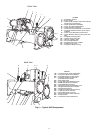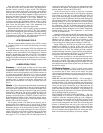
10
There is a display on the front of the Benshaw, Inc., solid-
state starters that is useful for troubleshooting and starter
checkout. The display indicates:
• voltage to the SCRs
• SCR control voltage
• power indication
• proper phasing for rotation
• start circuit energized
• over-temperature
• ground fault
• current unbalance
• run state
• software configuration
The starter is further explained in the Check Starter and
Troubleshooting Guide sections, pages 54 and 76.
Unit-Mounted Wye-Delta Starter (Optional) —
The 19XR chiller may be equipped with a wye-delta starter
mounted on the unit. This starter is used with low-voltage mo-
tors (under 600 v). It reduces the starting current inrush by con-
necting each phase of the motor windings into a wye configu-
ration. This occurs during the starting period when the motor is
accelerating up to speed. Once the motor is up to speed, the
starter automatically connects the phase windings into a delta
configuration. Starter control, monitoring, and motor protec-
tion is provided by Carrier’s Integrated Starter Module (ISM).
Unit-Mounted VFD (Optional) —
The 19XRV unit
will be equipped with a variable frequency drive motor control-
ler mounted on the unit. See Fig. 7 and 8. This VFD is used
with low voltage motors between 380 and 480 VAC. It reduces
the starting current inrush by controlling the voltage and fre-
quency to the compressor motor. Once the motor has accelerat-
ed to minimum speed the PIC II modulates the compressor
speed and guide vane position to control chilled water tempera-
ture. The VFD is further explained in the Controls section and
Troubleshooting Guide section, pages 10 and 76.
There is a separate display located on the unit-mounted
VFD. Operational parameters and fault codes are displayed rel-
ative to the drive. Refer to specific drive literature along with
troubleshooting sections. The display is also the interface for
entering specific chiller operational parameters. These parame-
ters have been preprogrammed at the factory. An adhesive
backed label on the inside of the drive has been provided for
verification of the specific job parameters. See Initial Start-Up
Checklist section for details.
CONTROLS
Definitions
ANALOG SIGNAL — An analog signal varies in proportion
to the monitored source. It quantifies values between operating
limits. (Example: A temperature sensor is an analog device be-
cause its resistance changes in proportion to the temperature,
generating many values.)
DISCRETE SIGNAL — A discrete signal is a 2-position rep-
resentation of the value of a monitored source. (Example: A
switch produces a discrete signal indicating whether a value is
above or below a set point or boundary by generating an on/off,
high/low, or open/closed signal.)
5
1
2
3
6
4
7
LEGEND
Fig. 5 — Solid-State Starter Box,
Internal View
1 — RediStart MICRO™ Input/Output Card
2 — Fuses 1-4 (Hidden, not depicted)
3 — Circuit Breaker 2 (CB2): Machine Control and Heater Power
4 — Circuit Breaker 3 (CB3): Oil Pump Power
5 — RediStart MICRO Central Processing Unit Card (CPU)
6 — RediStart MICRO Power Card (hidden, not depicted)
7 — RediStart MICRO Bypass Card (hidden, not depicted)
Fig. 6 — Typical Starter External View
(Solid-State Starter Shown)


















